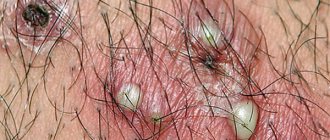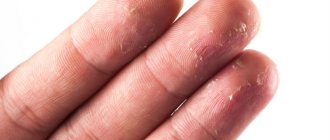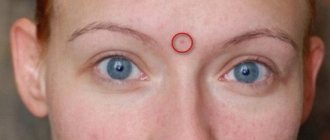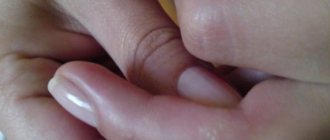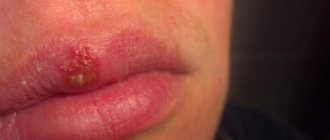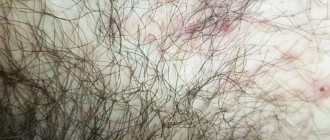Predisposing factors
Since a lump on the gum is only a manifestation of the underlying disease, there are many reasons that contribute to its development and they depend on the disease.
The main factors include:
- presence of carious teeth;
- frequent gum injuries;
- lack of oral hygiene;
- developmental anomalies of the maxillofacial skeleton.
The above deviations relate to pathologies of the oral cavity. A tumor-like formation on the gum can develop as a result of other somatic abnormalities:
- lack of vitamins;
- chronic foci of inflammation in the body;
- malignant neoplasms;
- disruptions in the hormonal regulation system.
Children are characterized by changes in gums due to low-grade inflammatory processes and consumption of foods low in vitamins. This is due to poor development of the immune system and poor absorption of substances.
Malignant tumors of various localizations often metastasize to systems located far from the primary localization of the tumor. One of these organs may be the maxillofacial skeleton.
Lumps due to hormonal disorders are common in women during pregnancy and menopause, when the body undergoes serious changes.
A purulent growth on the gum appears for various reasons. A white bump on the gum can be removed at the dentist or using folk remedies.
The coating on the tongue can be of different colors. This time we’ll talk about the reasons for the gray coating on the tongue. Read more about this here.
Did you know that a lump on a child’s gum can lead to dangerous complications, including tooth loss or sepsis? In this topic https://zubki2.ru/detskaya-stomatologiya/desna/shishka-na-desne-u-rebenka.html we will analyze the process of treating an unpleasant formation.
Why does the disease occur?
Cancer cells usually develop from spongy bone marrow, periosteum, neurogenic cells, blood vessels and odontogenic structures. The reasons for the development of this disease have not yet been fully studied. However, experts have established several main factors that cause jaw cancer to develop:
- The injury is chronic. This includes a bruise, an incorrectly installed crown, filling, as well as a prosthesis that causes constant rubbing of the gums.
- Damage to the oral mucosa.
- Inflammatory process.
- Smoking.
- Ionizing radiation.
Knob-like protrusion of the gums due to periodontitis
The teeth are fixed in the sockets by a connective tissue layer called periodontium.
When it becomes inflamed, swelling spreads to the gum tissue, resulting in local swelling.
A periodontal lump is formed due to the spread of bacteria and the inflammatory process in the tissue located around the root of the tooth.
- hard consistency (hard lump on the gum like a bone);
- usually painful;
- usually white or pink;
- clearly limited;
- does not spread to adjacent tissues;
- localized above the affected tooth.
In this case, as a result of the melting of the tissue, a fistula is formed - an opening through which pus swells. During this period, inflammatory contents begin to be released from the cone, but it does not decrease in size.
The first signs of cancer and benign tumors
If a lump appears on your chin, you should visit a doctor. You won't be able to solve the problem on your own. Ignoring an obvious symptom and other characteristic signs can cost the patient’s life.
Signs of a benign neoplasm: the lump at the bottom of the chin is soft and mobile to the touch; upon palpation, slight discomfort or severe pain may be felt. In the latter case, the symptom indicates severe inflammation.
A large pimple on the chin may be a lipoma. Lipoma is a benign formation that is formed from growing adipose tissue. In 98% of clinical pictures, there are no subjective sensations other than appearance.
If the tumor grows rapidly, pain is observed due to compression of surrounding tissues. The lump is soft and elastic to the touch, the size varies from 1 to 5 centimeters, most often it forms on the neck.
It is a skin pathology. In medical practice, the disease is classified as a form of superficial pyoderma. The disease is accompanied by inflammatory processes in the upper parts of the hair follicles. It is infectious in nature.
There are several types of folliculitis, which are caused by a specific pathogen. There are staphylococcal, candidal, herpetic, acne and other varieties.
A tumor containing malignant cells appears as a cancer. It is difficult to describe the initial symptoms of cancer, since there are many types of them. External manifestations include swelling and compaction under the skin. They usually develop in advanced stages.
Additional symptoms: painful lymph nodes, enlarged liver, neurological phenomena (dizziness, constant headaches), joint pain, non-productive cough (sometimes mixed with blood).
The main methods of therapy include surgery, chemotherapy, radiotherapy, taking hormonal pills, and the use of powerful medications aimed at strengthening the immune status. The prognosis is determined by the type of disease and timely diagnosis.
A closed cavity neoplasm of the skin and mucous membranes, which is lined with epithelial tissue or epidermis, containing contents of varying consistency - a skin cyst of true nature. The pseudocyst lacks an epithelial lining.
The compaction in the form of a cyst tends to grow quickly, which leads to subsequent rupture of the walls of the neoplasm; the contents enter the dermis, which provokes the development of a strong inflammatory process. Pain syndrome is noted.
The compaction is of a benign nature, contains sebum inside, and does not pose a threat to human life and health. With active growth, it can compress neighboring tissues, which leads to inflammation.
Lump on the gum due to periostitis
The upper and lower jaw, like other bones in the human body, are covered with a connective tissue membrane - the periosteum.
Inflammation of this structure is called periostitis.
Popularly, this pathology is called gumboil.
A lump-like protrusion is formed due to exfoliated periosteum above the inflammatory focus.
The tumor has characteristic signs:
- big sizes;
- severe pain;
- swelling spreading to surrounding tissues;
- without clear boundaries;
- bright red color.
Due to diffuse inflammation, the lump spreads to the tissues of the cheek and adjacent areas of the gums.
The pain reaches such intensity that the patient cannot open his mouth, talk or eat normally.
In addition, there are a number of common manifestations that make it possible to distinguish a lump in this disease, associated with the inflammatory process. The following come to the fore:
- weakness;
- increased body temperature;
- decreased performance;
- loss of appetite.
Causes
The following factors can provoke the growth of adipose tissue:
- Violation of lipid metabolism in the body.
- Heredity.
- Hormonal imbalance.
- Diabetes.
- Vitamin deficiency.
- Exposure to ultraviolet radiation.
- Skin contact with harmful substances.
- Smoking and drinking alcohol.
- Poor nutrition.
Lipomas on the face occur in patients of different ages and genders.
Neoplasms
Among the tumors developing on the gums, the most common are:
Papilloma is a benign neoplasm that develops from the squamous epithelium of the gums.
It has a soft consistency and light pink color. In most cases, its size does not exceed a centimeter.
The tumor grows slowly and only causes inconvenience when eating and talking. If injured, it can bleed heavily.
Fibromas are formed from connective tissue - dense formations, usually localized on the alveolar process of the upper jaw. Such tumors do not grow into neighboring tissues, but can cause moderate pain.
Osteogenic sarcoma is a malignant tumor of bone tissue.
This neoplasm has the following characteristics:
- fast growth;
- intensive invasion, that is, the ability to grow into neighboring tissues;
- frequent pain;
- accompanying changes in general condition - weakness, weight loss, severe fatigue.
If the first two tumors do not cause much harm to health, then the latter is a dangerous disease that requires serious treatment.
One of the common reasons for visiting the dentist is a lump on the gum above the tooth. In this article we will look at why some lumps cause pain, while others do not hurt at all.
Read about ways to get rid of yellow plaque on teeth in children and adults at the link.
It should be noted that only a doctor can accurately determine the type of tumor after a biopsy, that is, a microscopic examination of the tissue.
Thus, lumps on the gums need to be treated with special attention so as not to miss the onset of serious abnormalities in the body.
What diseases may be indicated by the appearance of a lump under the jaw?
The appearance of a lump under the jaw on the right, left or near the ear can greatly alarm a person. But this does not mean that you have suffered a dangerous disease. To figure out what it is, you need to see a doctor, he will clarify the diagnosis and prescribe effective treatment specifically for your case.
Such formations can be of very different etiologies and require consultation with several specialists. From a common pimple and clogged sebaceous glands to tumors (benign or malignant) - a bump can indicate anything. Therefore, it is worth getting examined in a timely manner.
Read also: Dark spot on the gum near the tooth
Under the chin
Sometimes they are located on the chin closer to the teeth or lower, in the neck area. There are many reasons for such formations. The most common are the following:
- A lump under the jaw on the right or left indicates inflammation of the lymph nodes, lymphadenitis. In this case, one or several hard balls are formed that roll under the skin. They are quite mobile, but painful. In addition, body temperature may rise, general condition may worsen, and other symptoms of the underlying disease may appear.
- If a lump under the jaw on the left or right does not go away for too long and the reasons for its appearance are not addressed in any way, it can become more dense and become a chronic form of formation. At the same time, the size increases, it becomes hard, and the pain goes away. The absence of clear symptoms does not indicate the safety of the process and the end of inflammation. Even such a tumor needs to be checked and understand where it came from. Any diseases of the ENT organs, teeth, throat or lymph nodes will lead to increased discomfort.
- In the most advanced cases, such a formation develops into a malignant tumor. Then the general symptoms and condition of the patient worsens significantly. In this case, purulent processes and the formation of fistulas may begin, which indicate severe infection of the tissues.
- Lipoma is quite soft and elastic to the touch, mobile. When large volumes are reached, it compresses the nerve endings and manifests itself as painful sensations.
- An inflamed follicle, that is, an internal pimple that forms under the skin for a long time. It's quite painful. This happens as a result of blockage of the sebaceous glands. This is the most common cause of a lump on the neck under the jaw.
- The same formations sometimes manifest themselves in other diseases - herpes, stomatitis, atheroma, skin cyst, dermatological problems, etc.
- Another cause of a formation on the chin can be a common injury. Then an internal hematoma will immediately form in the affected area. It will be hard and dense to the touch, have clear boundaries and be quite painful.
What could it be - the causes of a tumor on the chin
If the development of a tumor under the chin occurred suddenly, then this is not a reason to sound the alarm. Most likely, this is a peculiar manifestation of local inflammation and an internal pimple with a purulent pustule has formed in the subcutaneous layer, formed as a result of penetration of a pathogenic infection into the skin. Also, the appearance of a lump under the chin that resembles a tumor may be due to the following reasons.
Popularly, a lump of this nature of origin is called a wen. This is a truly benign neoplasm, which consists of excess accumulation of fat in the subcutaneous layer. Due to the fact that fatty tissue accumulates in the same segment of the epithelial cover, a compaction is formed and the fat clot resembles a tumor body. Lipoma is practically unable to transform into a malignant formation, therefore it is considered safe for the human body. Most of all, it brings aesthetic and psychological discomfort. The danger comes from the wen, which has begun to turn red, inflamed and painful. This is a clear sign of the development of a pathological condition of adipose tissue and surrounding tissues of the epidermis.
This is inflammation of the hair follicle. In women, this disease is rare, but is still periodically diagnosed in medical practice. Ladies who have excess hair in the chin area are susceptible to the disease. As a rule, women aged 45 years or more are at risk. Hormonal changes in the body lead to the fact that even the smallest hair follicles cease to receive the required amount of nutrients and this leads to their inflammation as a result of the pathological process in the follicle.
Where the hair follicle is located, sanguineous fluid and purulent contents begin to accumulate. These biological fluids form a kind of pustule, which upon palpation resembles a tumor. The formation is dangerous because inflammation and swelling of tissues can spread to the larynx area and affect the respiratory tract. If, in addition, a bacterial infection of the inflamed follicle occurs, the consequences for the patient’s health can be very sad, and the treatment can be lengthy using potent antibacterial drugs.
It is a benign sebaceous gland cyst located in close proximity to the chin. Atheroma is formed under the influence of excessive synthesis of sebum by the glands, which, when functioning stable, should secrete just enough secretion to ensure sufficient hydration of the skin of the neck around the chin. If the sebaceous gland begins to produce too much sebum, the skin pores become clogged and fat begins to accumulate in the subcutaneous layer, forming a cyst.
In fact, this is one of the types of wen, but the nature of the formation of this tumor is slightly different from how a lipoma is formed.
In dermatology, this neoplasm is called an epidermal cyst. It occurs in the chin area due to metabolic disorders in epithelial cells. In the future, this leads to the appearance of small voids in the surface layer of the skin. This is considered a deviation from the normal state of the skin and the body fills the voids with keratinized particles of the epidermis, which in their structure resemble fibrous tissue. As a result of this, a dense knot is formed under the chin, which, upon palpation and visual inspection, in all its characteristics resembles a dense lump. Quite often, a skin cyst has a bluish tint, which is associated with an effect on the smallest vessels, capillaries, and a violation of the venous outflow of blood in this part of the body.
The most terrible and dangerous diagnosis, indicating the development of an oncological process in a person. This reason for the presence of a lump in the chin area is provoked by negative factors present in the patient’s life, which provoked the degeneration of previously healthy epithelial cells and the formation of a tumor. If treatment was started at stages 1-2 of cancer development, then the prognosis for recovery is quite high. At later stages, the process of metastasis begins and, at first glance, a very harmless chic produces millions of malignant cells into the blood, capable of forming similar tumors in any part of the sick person’s body.
If pyogenic microbes enter the skin in the chin area, acute inflammation of the deep epidermal tissues occurs. As a result of this, the patient observes a rapidly increasing lump under the chin, which is painful, swollen, and the surface of the skin has a red and inflamed appearance. Most often, a lump under the chin of this nature occurs as a complication after suffering a sore throat with bacterial damage to the mucous membrane of the throat due to a streptococcal infection, or the presence of chronic tonsillitis in the patient.
The latter disease in most cases is provoked by invasion of the tonsils by a strain of Staphylococcus aureus. This biological agent very often affects epithelial cells in the area of its localization. As the purulent contents mature, the lump in the form of an abscess becomes soft and if it has not been surgically removed, the skin is able to cleanse itself by breaking through the infectious tumor with the release of purulent contents.
In the ear area
A lump appears near the ear in a variety of places. It can be localized under it, behind the ear, or closer to the chin and jaw. Such formations are quite rare and account for no more than 0.2% of all other facial defects. Their consistency, structure and reasons can also be very different.
- The same lymphadenitis, which changes its location depending on the affected area and the accumulation of infection. And although it is not considered a life-threatening disease, it is still necessary to eliminate the source of inflammation as early as possible. It can become acute or chronic, become purulent, and, in the absence of proper treatment, end in sepsis.
- Similar to previous formations, lipoma can also affect the ear area. This is a benign tumor, popularly called a “wen.” It is more of a cosmetic problem than a serious disease.
- Hormonal imbalances, low immunity, hypothermia and even excessive sweating are all common companions of parotid lumps.
- Their appearance is also caused by various general infections, which carry pathogenic bacteria through the bloodstream to various parts of the body.
- As a result of otitis media and other ear diseases, a lump may appear immediately behind or under the ear.
An infectious disease such as mumps (mumps) also leads to tumors behind the ears. In this case, the salivary glands located next to the ears become inflamed and significantly increase in volume. In addition to swelling in the jaw, the patient’s temperature rises, chills, weakness, and pain in the affected areas occur. It must be remembered that this disease requires not only medical intervention, but also isolation of the patient, since the infection is highly contagious.
Lymphoma is manifested not only by the presence of tumors, often several at once, fused together, but also by mild swelling of the post-auricular area. And although even with pressure there is no painful sensation, over time a person begins to feel general fatigue, depression, decreased tone, and weight drops sharply. All this indicates a rather serious pathology, a malignant formation, which should not be ignored.
Possible complications if the lump is not treated, which doctor should I contact?
If you find a lump under your chin, this tumor cannot be ignored. You should immediately seek help from a surgeon. Foreign external and subcutaneous formations, regardless of their nature of origin, are the domain of a specialist in the field of surgery. The doctor will conduct a visual examination of the tumor, palpate it, and then write a referral for tests. Having received data on the patient’s health condition, the doctor will be able to prescribe appropriate treatment. In the absence of proper therapy, complications such as:
- inflammatory swelling of the larynx with the onset of suffocation;
- sepsis caused by infection in the blood, lymph and bone marrow;
- development of the tumor up to stage 4 with the spread of metastases throughout the body and imminent death;
- compression of blood vessels with disruption of local circulation.
There are many options for complications of the clinical picture of the disease, depending on the etiology of the lump and how long it has been present in the subcutaneous layer of the chin area.
The appearance of swelling in the facial area is not only a cosmetic defect, but also a symptom of a malfunction in the body. A lump on the chin occurs due to various reasons and provoking factors. Often patients panic, believing that it is an oncological tumor. This possibility exists, but the tumor also appears due to another etiology that is not related to cancer processes in the body. Let's consider why swelling appears on the skin and what it could be?
- Lump under the chin
- Why did a lump appear on the neck under the chin?
- The first signs of cancer and benign tumors
- Lipoma
- Folliculitis
- Malignant tumor
- Skin cyst
- Atheroma
- Who should I contact if I have a lump under my chin?
On the jaw under a tooth
Also, similar bumps appear closer to the dentition - above or below. Sometimes this formation is on the cheek under the skin in the jaw area, and in other cases it is completely located on the mucous membrane, in the mouth. Then you need to contact a dentist who can determine the main reason for their appearance:
- internal fistulas - looks like a red lump with a diameter of about 5 mm, in the middle there is pus, which is secreted along the edge by a white dot;
- a consequence of periodontitis - which can also manifest itself in the form of a purulent formation, but does not cause pain;
- periostitis - inflammation of the periosteum, which in a neglected state ends with the appearance of an abscess that breaks into the gum and releases pus;
- cyst - a pathological formation, dense to the touch, painless, but provokes constant bad breath;
- benign tumors of the jaw system;
- as a result of the eruption of baby or permanent teeth, which is normal, but requires examination and consultation with a doctor;
- even untreated caries can lead to the accumulation of pathogenic bacteria in the form of a lump on the mucous membrane, closer to the root of the tooth;
- as in all previous cases, this problem can arise as a result of injury to the tooth or jaw.
Read also: The gums rise above the tooth, what to do?
We determine the disease by x-ray
So, how can you detect jaw cancer using an x-ray? Diagnosis of this disease is a complex process. X-ray allows you to determine the presence of pathology by the following signs:
- Bone destruction.
- Destruction of spongy loops.
- Blurred contours of transitions of healthy bones into the area of destruction.
- Intertwined stripes formed as a result of the merging of several foci of destruction.
When do you urgently need to see a doctor?
These bumps, which are the result of clogged sebaceous glands or are painful pimples, may go away on their own over time and leave no trace. Still, you should not hope that the tumor will resolve on its own. The sooner it is diagnosed, the easier it is to remove.
Doctors list the following dangerous symptoms, in which you should immediately contact a medical facility:
- a sharp increase in the size of the cone;
- its large size;
- there is sensitivity and pain in the affected area;
- the formation appeared for no apparent reason, there was no known viral or infectious disease;
- the skin on the tumor changes color and darkens;
- there is a noticeable accumulation of pus inside;
- there are other signs of general malaise - fever, headache or ear pain, etc.
Video: the lymph nodes in the neck are inflamed.
Diagnosis and treatment
So that the doctor can accurately determine what exactly the formation is associated with and what its origin is, you need to undergo an examination using X-rays and ultrasound. Based on these indicators, the specialist will accurately diagnose and distinguish one disease from another.
Among the treatment methods, a variety of manipulations can be used, everything will depend on the specific pathology. Thus, for inflammatory processes and infections, specific drugs are prescribed that can eliminate the main focus of the disease. When a cyst, atheroma or benign tumors forms, a minor operation is usually performed to remove it.
If a malignancy is suspected, an additional biopsy and histological examination are performed. If cancer is still detected, the oncologist will deal with the treatment process.
In cases of dermatological problems, acne formation, blockage of the sebaceous glands and frequent recurrences of boils, the doctor prescribes special treatment to prevent further similar conditions.
If the cause is diseases of the ENT organs or dental pathologies, they should be treated by a dentist as early as possible. After all, an infection from a diseased tooth or ear quickly spreads to other organs and leads to additional diseases.
If there are purulent formations in the oral cavity, you can perform antiseptic rinses with special solutions along with general treatment. But you shouldn’t decide on their choice on your own. Any folk recipes or pharmaceutical products are used only after consulting a specialist.
It is highly recommended not to do the following before consulting a doctor:
- heat the affected area;
- apply cold compresses;
- take any medications without prescription;
- squeeze out purulent or fatty formations;
- pierce the tumor and physically influence it in some other way.
All this can lead to an increase in unpleasant symptoms or a complication of the underlying disease, the spread of infection to other areas.
Jaw cancer: treatment
Pathology therapy is complex. It includes not only surgery, but gamma therapy. Surgeries are being carried out to remove the jaw. This may be disarticulation or resection. Jaw cancer is not treated with chemotherapy, as it does not produce results.
To begin with, the patient is subjected to gamma radiation. It allows you to significantly reduce the size of the cancer tumor. Three weeks later, the jaw is removed. In some cases, more extensive surgery is required, which often includes orbital exenteration, lymphadenectomy and debridement of the paranasal sinuses.
Swelling under the jaw
A lump under the jaw on the left or right can be caused by a variety of factors. This phenomenon often takes a person by surprise, and swelling forms in just a few hours. As a rule, the situation is aesthetic in nature and spoils a person’s appearance, but does not cause painful sensations.
The symptom is quite common , since there are many lymph nodes in this area and the problem may be related to their work, especially if there is a lump under the lower jaw on the right or left.
The culprit may be pathogenic microflora that enters the lymphatic system.
Inflammation of the submandibular lymph nodes
There are also many known factors that provoke the appearance of this symptom:
- cysts;
- malignant and benign formations;
- folliculitis.
Many people tend to overthink themselves and panic when they see these kinds of symptoms on their face. A distinctive characteristic is the fact that pain is not observed, so you should not immediately assume that you have oncology or other serious diseases.
After operation
Several years after the operation, orthopedic correction is required, which allows you to hide all the defects. It is usually carried out using various bone plates and splints. Such procedures require patience from the patient, since in some cases there is a need to restore swallowing and chewing functions, as well as speech.
It is worth noting that restoration of the lower jaw is a very complex process that does not always end successfully. In such situations, stainless steel, tantalum, and plastic are often used to fix implants.
Lumps under the jaw: therapy
If the symptoms are accompanied by pain, you should immediately visit your doctor to determine the exact cause that caused the lump. The first step is to contact a physician or dentist . If you are diagnosed with lymphadenitis, drug therapy will be carried out, aimed at suppressing pathological foci.
With high-quality and correctly selected therapy for lymphadenitis, nothing will be left of the formation, and you will quickly return to your usual lifestyle.
Tumor formations are usually excised surgically or using a laser. You should not ignore the problem, because if the tumor is elastic and mobile, you should consult a doctor as early as possible.
There are the following reasons for this:
- a small tumor is removed without the occurrence of negative complications;
- with a small formation, you can get rid of the lipoma without making a surgical incision.
If an internal pimple is to blame, it can easily go away on its own, but this does not mean that this phenomenon should be left to chance. If the skin becomes red or swollen, you should immediately consult a doctor. Modern treatment methods are quite effective and help prevent the appearance of new rashes.
Read also: What foods strengthen teeth
If a lump appears under the jaw, you should urgently visit a doctor
A qualified doctor can easily distinguish a regular pimple under the skin from inflammation of the lymph nodes using a visual examination. You should not try to “help” yourself in every possible way by squeezing out the formation, warming it up or applying compresses. Treatment should be entrusted only to a professional.
Preventive measures
The understanding of the causes of subcutaneous neoplasm remains vague, so it is impossible to accurately determine measures to prevent the disease. Doctors are of the opinion that disorders of lipid metabolism of the skin, diseases of the digestive system and failure to comply with hygiene rules are possible causes of the disease.
Dermatologists advise sticking to a healthy lifestyle, eliminating junk food from your diet, adding exercise to your daily routine, and regularly caring for your skin using pharmaceutical and cosmetic products. Annual scheduled examinations and regular visits to a dermatologist, cosmetologist and therapist will protect a person from the occurrence of painful lipomas.
Lump on jaw near ear
A lump in the jaw area may indicate that a person has lymphadenitis, which usually occurs due to infection. It is worth considering that the lymphatic system always responds very sensitively to what is happening in the human body , especially when the source of infection is located nearby.
As a rule, the inflammatory process occurs as a result of pathological processes in the ENT organs and the oral cavity. This phenomenon can be caused by other, more rare pathologies. Only an experienced doctor can confirm or deny their presence.
The resulting formation can be soft on palpation, elastic or dense. The latter indicates the presence of a benign neoplasm.
Based on the size, an experienced specialist can determine the cause of the disease: the larger it is, the greater the likelihood of a malignant process. If the pathology is sluggish, the bumps are painless and enlarged. But when an infection enters a pathological focus, a relapse immediately occurs, accompanied by severe pain.
If the discomfort becomes unbearable, it is likely that there is a large amount of pus in the tumor or other complications have occurred.
Sometimes, during malignant processes, lumps form near the ears. In this situation, it is worth paying attention to other clinical manifestations. If toothache and other dental pathologies occur, gums become thickened, lacrimation appears, the patient requires a thorough medical examination. Treatment will depend on the exact cause of the symptom.
Factors causing the occurrence of wen
The reasons for the appearance of a subcutaneous tumor are still not clear, but possible factors include:
- heredity;
- neglect of hygiene rules;
- presence of bad habits;
- physical and chemical effects on the area where pathology occurs;
- diseases of the digestive organs and slow metabolism;
- excessive consumption of junk food;
- hormonal imbalance in the body;
- lipid imbalance of the skin;
- diabetes;
- infectious skin lesion.
Lump on the lower jaw behind the ear: what to do
Sometimes this symptom goes away on its own. But there are certain diseases that cause swelling and require serious treatment.
What to do in this situation? Do not delay going to a medical facility in order to find out an accurate diagnosis as quickly as possible. Of course, recovery can only be achieved using this method. The use of any medications or alternative medicine methods without the permission of a doctor will only aggravate the pathological process.
You should rush to the doctor and put aside all your business, especially if:
- lymph nodes are very enlarged in size;
- the pathological focus is very sensitive and painful;
- the cause of this symptom is not related to ARVI;
- the formation is filled with purulent contents and becomes a different color;
- the patient exhibits other clinical signs.
If a lump has formed behind the ear, therapy may include taking antifungals and antibiotics that are aimed at inhibiting the spread of infection and the formation of connective tissue. Particular emphasis should be placed on the hygiene of the affected area, to prevent its contamination and friction with things.
Salivary gland tumor
If there is a cyst, the patient is given cortisone injections and surgery under local anesthesia or laser exposure is indicated. The medicine can be injected directly into the pathological focus itself. At the same time, the adipose tissue is absorbed and the formation disappears.
Lumps that have formed as a result of cancer require special attention and detailed examination. An experienced oncologist should treat such patients.
If the lymph nodes are inflamed, it is necessary to fight the virus or infection that caused this phenomenon. Only a doctor can prescribe effective treatment tactics.
Types of skin pathologies
Wen that appears in the neck area are divided into the following types:
- a tumor consisting entirely of adipose tissue and having a capsule is called a soft tissue wen;
- a large wen without a capsule is known as a diffuse tumor;
- a growth that has a hardened capsule inside, consisting of both fatty and connective tissue, is called a fibrous tumor;
- a neoplasm partially consisting of muscle tissue is called myolipoma;
- multiple formations spreading to the head and neck area are called lipomatosis;
- the wen that touches the nerve fibers is called perineural;
- a tumor containing calcium is known as angiolipoma;
- a growth affecting the sweat glands is called adenolipoma;
- a wen that arises on the cervical vertebra and blocks the blood duct is known as Bichat's hump.
Lump on jaw under tooth
Patients often find lumps on their gums. The problem can be caused by many factors. Seals occur as a result of an inflammatory process, chronic damage to the tooth root . H
To make an accurate diagnosis, it is necessary to take an x-ray:
- internal fistulas. In this case, the gums become red and thickened. The size of the formation reaches approximately five millimeters. The white end of the lump indicates that the pus will soon come out. Experts recommend doing soda and salt rinses at home;
- a lump on the gums can form due to periodontitis . In this case, the pathological process causes a fistula, which breaks out. Due to this, a person may feel absolutely no pain. The doctor determines the treatment tactics and it may not necessarily be a dental problem. In this case, the prognosis is favorable;
- periostitis . With this pathology, inflammation of the periosteum occurs. A lump appears on the gum in the root area, and the collected pus makes its way through the bone tissue and breaks out. In this case, a lump forms on the gum;
- Cysts often appear on the gums . At the same time, they do not hurt, are dense to the touch, and an unpleasant aroma constantly emanates from the mouth. The diagnosis can only be made after an x-ray;
As you can see, there are many reasons for the appearance of bumps on the lower and upper jaw. Some formations are very dangerous, some are harmless, but also require attention. Remember that even the most harmless suppuration can lead to poisoning of the entire body.
Purulent formations that occur from time to time indicate weak immunity, lack of vitamins, and neglect of hygienic principles. This may also be the consequences of systemic pathologies and infectious lesions. All this, of course, requires immediate treatment.
When diagnosing a lump in a child, you should immediately visit a doctor. This condition requires mandatory treatment. Otherwise, suppuration of the root will lead to damage to the tooth buds. The likelihood of such an outcome is very high, so do not self-medicate, but go straight to a medical facility.
Prevention of pathology development
The development of pathology can be prevented by following certain preventive rules:
- It is important to brush your teeth thoroughly every day;
- You should periodically have your teeth professionally cleaned to remove tartar and plaque;
- You must contact your dentist promptly if any unpleasant symptoms or pain occur;
- preventive examinations at the dentist, carried out twice a year, will detect pathological changes at the earliest stages of development;
- It is important to follow nutritional rules, eat a variety of foods rich in various vitamins, minerals, containing large amounts of fluorine and calcium.
It should be remembered that only timely diagnosis of the disease and therapy in accordance with the recommendations of a specialist will prevent the development of undesirable consequences.
A lump of swelling under the chin that appears suddenly indicates compaction of the epidermal tissues or excessive accumulation of fatty tissue. If a dense nodular lump has formed around the chin, this does not necessarily mean that the nature of the origin of this neoplasm is necessarily malignant. It is quite possible that the tumor is benign and developed under the influence of certain pathogenic factors present in a person’s life. With timely treatment, the occurrence of a full-fledged cancer tumor can be avoided.




